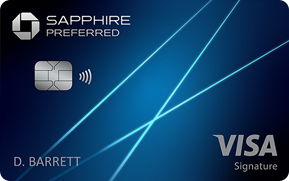
Not sure whether to pick the Chase Sapphire Reserve vs Preferred? Both are great cards, but the choice between them can be confusing. You might worry about paying a high annual fee for benefits you won’t use or, conversely, not getting enough rewards from the Preferred. Let me help you navigate through the differences, offering a detailed breakdown to ensure you pick the card that aligns with your needs and lifestyle.
Comparison: Chase Sapphire Reserve vs Sapphire Preferred
Before I proceed, here’s a side-by-side breakdown to help you quickly decide:
Chase Sapphire Reserve |
Chase Sapphire Preferred |
|
|---|---|---|
Welcome Bonus |
60,000 points (worth $900 in travel) |
60,000 points (worth $750 in travel) |
Annual Fee |
$550 |
$95 |
Travel Credit |
$300 annually |
None |
Dining Rewards |
3X points |
3X points |
Travel Rewards |
5X points through Chase Travel |
5X points through Chase Travel |
Streaming & Online Grocery |
Not included |
3X points |
Lounge Access |
Included via Priority Pass Select |
Not included |
Point Value for Travel Redemption |
1.5 cents per point |
1.25 cents per point |
Foreign Transaction Fees |
None |
None |
Extra Perks |
Lyft (5X points), Peloton (10X points) |
Lyft (5X points), DoorDash benefits |
Chase Sapphire Reserve vs Sapphire Preferred: Overview
What Is the Chase Sapphire Reserve Card?
The Chase Sapphire Reserve is a premium travel rewards credit card designed for those who love luxury and adventure. Issued by Chase, one of the largest and most trusted financial institutions in the U.S., this card is all about enhancing your travel experiences. It offers elevated points on travel and dining, exclusive perks like Priority Pass lounge access, a $300 annual travel credit, and extensive travel and purchase protections. The card is geared toward frequent travelers who want top-tier benefits and don’t mind paying a higher annual fee to unlock unparalleled rewards and perks.
What Is the Chase Sapphire Preferred Card?
The Chase Sapphire Preferred is a versatile travel rewards card, also issued by Chase, tailored for individuals who want to earn travel rewards without breaking the bank. Known for its affordable $95 annual fee, the card lets you rack up points on dining, travel, and other everyday purchases. It’s ideal for beginners or occasional travelers looking to maximize value through Chase’s Ultimate Rewards program, where points can be redeemed for travel, cash back, and more. While it lacks some of the premium perks of the Reserve, the Sapphire Preferred remains a standout card for its simplicity, affordability, and excellent rewards structure.
Welcome Bonus
When it comes to welcome bonuses, both cards come out swinging, but one edges ahead depending on how you use your points.
- With the Chase Sapphire Reserve, you’ll earn 60,000 points after spending $4,000 in the first three months. Those points are worth $900 toward travel when booked through Chase Ultimate Rewards, thanks to the Reserve’s 50% point boost. It’s a high-value start, especially for frequent travelers.
- The Chase Sapphire Preferred also offers 60,000 points for the same $4,000 spend within three months. However, points redeemed for travel through Chase Ultimate Rewards get only a 25% boost, meaning this bonus is worth $750 in travel value. Still impressive, but a bit less than what the Reserve offers.
If you’re planning to travel soon and want maximum redemption power, the Reserve’s higher bonus value can go a long way. But if you’re just getting into the points game, the Preferred’s lower annual fee (which I’ll dive into next) might make it a better starting point.
Chase Sapphire Reserve vs Preferred: Annual Fees
Let’s talk about the elephant in the room: the annual fees.
- The Chase Sapphire Reserve charges a hefty $550 per year, but it’s packed with premium perks that help offset that cost. For starters, you get a $300 annual travel credit, which works automatically for anything coded as travel (flights, hotels, rideshares, etc.). That effectively brings the net fee down to $250, not to mention other perks like lounge access and travel protections that easily make up the rest if you’re a frequent traveler.
- On the flip side, the Chase Sapphire Preferred is much lighter on your wallet, with an annual fee of just $95. It doesn’t come with premium credits, but it does include a $50 annual hotel credit when you book through Chase Travel, which helps chip away at the cost.
In short, the Reserve is ideal if you travel often enough to make the perks worthwhile. The Preferred keeps things simple and affordable, offering great rewards without breaking the bank. It all comes down to how much value you’ll extract from each card. For me, the Reserve makes sense when I’m traveling frequently, but I can see how the Preferred is a smarter pick for more occasional spenders.
Rewards Structure
When it comes to earning points, Chase Sapphire Reserve vs Preferred cards share the same core structure, but the Chase Sapphire Reserve takes it up a notch with higher multipliers in key categories.
- Chase Sapphire Reserve: You’ll earn 3x points on dining and travel (including flights, hotels, rideshares, and more) and 1x point on everything else. If you book travel through Chase Ultimate Rewards, that bumps up to 5x points. For someone like me who loves dining out and traveling, those extra points really stack up quickly.
- Chase Sapphire Preferred: It’s no slouch either, offering 2x points on travel and 3x points on dining, plus bonus categories like online grocery purchases and select streaming services. Book travel through Chase, and you’ll earn 5x points, just like the Reserve. Everyday purchases earn the standard 1x point.
Both cards are generous, but the Reserve’s higher multipliers make it the better choice for frequent travelers and foodies. If your spending skews more toward occasional travel or mixed purchases, the Preferred’s slightly broader categories might suit you better.
Redemption Options
This is where Chase Ultimate Rewards really shines, and the card you pick can make a big difference in how far your points go.
- With the Chase Sapphire Reserve, points redeemed for travel through Chase Ultimate Rewards get a 50% boost. For example, 60,000 points translate to $900 in travel value. Plus, you can transfer points 1:1 to top travel partners like Hyatt, Marriott, and United Airlines, which can often stretch the value even further.
- The Chase Sapphire Preferred offers a 25% boost when redeeming points for travel through Chase, making 60,000 points worth $750. Like the Reserve, it also allows 1:1 point transfers to travel partners, which is a huge win for both cards.
For someone like me who loves scoring premium flights or luxury hotels, the Reserve’s 50% boost gives it the edge. But if you’re planning more budget-friendly trips or prefer cashback options, the Preferred still provides excellent value without the higher annual fee.
In short, both cards unlock incredible travel opportunities—you just have to decide how much value you want to squeeze out of your points.
Travel Credits and Perks
When it comes to perks, the Chase Sapphire Reserve is a clear winner, especially if you travel often.
- Chase Sapphire Reserve: It offers a $300 annual travel credit, which is incredibly easy to use. It automatically applies to almost any travel-related purchase—whether that’s a hotel, flight, Uber ride, or even parking fees. For me, this credit practically offsets a huge chunk of the card’s annual fee right off the bat. On top of that, you get Priority Pass lounge access at airports, which has been a lifesaver during long layovers. There’s also complimentary DashPass for no-fee DoorDash deliveries and Lyft Pink membership for discounted rides.
- Chase Sapphire Preferred: While it doesn’t offer a comparable annual travel credit, it does include a $50 credit for hotel bookings made through Chase Travel. This is great if you book through their portal, but it’s not as flexible as the Reserve’s credit. You also get complimentary DashPass, which is a nice bonus for dining at home.
For frequent travelers, the Reserve’s perks—especially the travel credit and lounge access—are hard to beat. But if you don’t fly as often or don’t value those extras, the Preferred still delivers solid benefits.
Travel and Purchase Protections
Both cards provide top-tier protections, but the Reserve takes it up a notch with added coverage and higher reimbursement limits.
- Chase Sapphire Reserve: It has some of the most comprehensive protections I’ve ever seen. For example, trip delay reimbursement kicks in after just six hours, covering up to $500 per ticket. There’s also primary rental car insurance, lost luggage reimbursement (up to $3,000 per passenger), and emergency evacuation coverage worth up to $100,000. When I travel, knowing I have this kind of coverage gives me peace of mind.
- Chase Sapphire Preferred: It offers many of the same protections, like trip cancellation/interruption insurance and rental car insurance, but trip delay coverage only starts after 12 hours. The reimbursement limits are slightly lower across the board, and it doesn’t include emergency evacuation coverage.
If you value high-end coverage for your trips, the Reserve is worth the investment. However, the Preferred still provides strong protection for the occasional traveler who wants reliable backup for unexpected issues.
Chase Sapphire Reserve vs Preferred: Additional Benefits
The Chase Sapphire Reserve and Sapphire Preferred each bring unique extras to the table, but the Reserve truly stands out if you love premium perks.
- Chase Sapphire Reserve: Beyond its travel-focused perks, the Reserve offers exclusive benefits like 10X points on Peloton equipment and accessories (up to $5,000 through March 2025). You’ll also get 5X points on Lyft rides through the same period. Plus, Reserve users have access to Chase’s Luxury Hotel & Resort Collection, which includes perks like free room upgrades and late checkout.
- Chase Sapphire Preferred: The Preferred shines for its simplicity. It features 3X points on select streaming services and online groceries (excluding major chains like Walmart and Target), which are rare categories to earn extra points. While it doesn’t boast luxury-focused benefits, it provides excellent everyday value for users who don’t need the bells and whistles.
If premium experiences are your thing, the Reserve has unmatched benefits. But if you prioritize everyday practicality, the Preferred offers a great mix of features that fit most lifestyles.
Point Valuation and Maximization Tips
Both cards earn points in Chase Ultimate Rewards, one of the most flexible and valuable rewards programs. The difference lies in how much each card enhances the value of your points.
- Chase Sapphire Reserve: Points are worth 1.5 cents each when redeemed for travel through the Chase portal, giving you incredible value. For example, 60,000 points equal $900 in travel! Add in transfer partners like Hyatt, United, and Southwest, and you can squeeze even more value out of your points. Personally, I’ve booked luxury hotel stays and first-class flights for a fraction of their cash price by transferring points strategically.
- Chase Sapphire Preferred: While its points are worth slightly less at 1.25 cents each through the Chase portal (60,000 points = $750 in travel), the Preferred also allows access to the same transfer partners. For many, this is a game-changer because you can still use those points for high-value redemptions without needing the higher annual fee.
Maximization Tips:
- Use transfer partners for outsized value—Hyatt and Singapore Airlines are my personal favorites.
- Combine points with other Chase cards like the Freedom Flex for even more earnings potential.
- Book travel through Chase to take advantage of the higher redemption rate offered by your card.
If you’re someone who prioritizes maximizing every point, the Reserve’s 1.5X value and luxury transfer opportunities make it the ideal pick. But if you’re happy with a strong, slightly lower value, the Preferred is a cost-effective way to make the most of Chase Ultimate Rewards.
Chase Sapphire Reserve vs Preferred: Which Should You Choose?
Choosing between the Chase Sapphire Reserve vs Preferred really comes down to your lifestyle and spending habits. Let me break it down for you.
- Chase Sapphire Reserve: This is the ultimate card for frequent travelers and those who crave luxury. If you value premium perks like airport lounge access, the $300 travel credit, and higher point redemption rates (1.5 cents per point through Chase Ultimate Rewards), this card is worth its higher annual fee. Personally, I’ve found the lounge access alone invaluable during long travel days. Add the strong travel protections and exclusive benefits, and it’s a card that pays off if you travel regularly or spend heavily in dining and travel.
- Chase Sapphire Preferred: If you’re looking for a more affordable option that still delivers strong rewards, the Preferred is a perfect fit. With its lower annual fee and a robust 3X points on dining, streaming, and groceries, it’s ideal for everyday spending. I recommend this card for those who want to dip their toes into rewards without the commitment of a premium card. It’s also a great starting point if you plan to later upgrade to the Reserve.
In short, the Reserve is perfect for those who want to elevate their travel experience, while the Preferred offers fantastic value for everyday spending and occasional travel.
Final Verdict
As you can see from this Chase Sapphire Reserve and Preferred comparison, there’s no “one-size-fits-all” winner—just the best card for your lifestyle. Personally, I’ve used both, and each card serves its purpose. The Reserve shines when I’m jet-setting, offering luxury perks that elevate my trips. The Preferred, however, is my go-to for everyday purchases and light travel. If you’re unsure, I’d recommend starting with the Preferred to get a feel for Chase Ultimate Rewards, and then upgrading later if you crave more perks. Either way, you’re getting a card that delivers incredible value.
Compare ↓
Chase Sapphire Reserve vs Robinhood Gold Card
FAQs
- Can I have both the Sapphire Reserve and Preferred?
No, Chase doesn’t allow you to hold both Sapphire cards at the same time. You can only have one Sapphire product per person.
- Is the Sapphire Reserve’s $550 annual fee worth it?
Yes, if you travel frequently. The $300 travel credit, lounge access, and higher point value (1.5x) for travel redemption can easily offset the fee for avid travelers.
- Can I upgrade from the Sapphire Preferred to the Sapphire Reserve?
Absolutely! You can request a product change after your account has been open for at least one year. Keep in mind, though, you won’t receive a new welcome bonus for upgrading.
- Do both cards waive foreign transaction fees?
Yes, both the Reserve and Preferred have no foreign transaction fees, making them excellent choices for international travel.
- What’s the biggest difference between the two cards?
The Reserve offers premium travel perks like lounge access, a $300 travel credit, and higher point value for redemptions (1.5x), while the Preferred focuses on strong everyday rewards and affordability with its lower annual fee.



